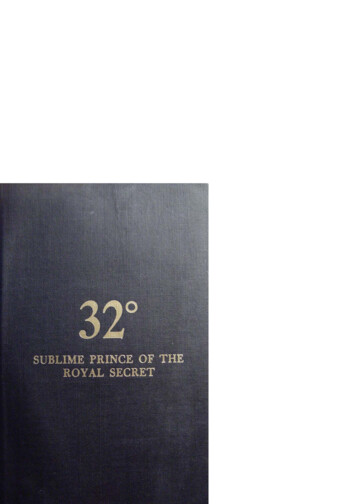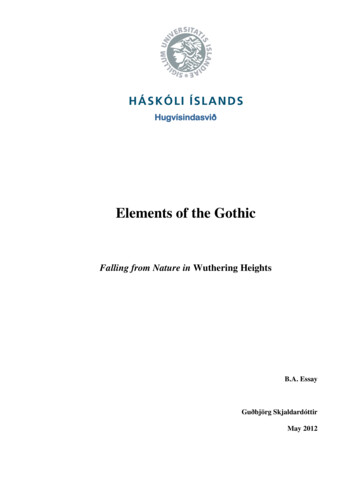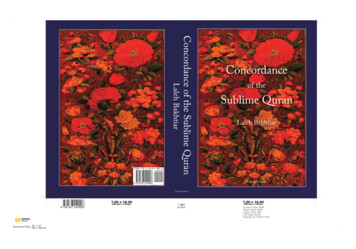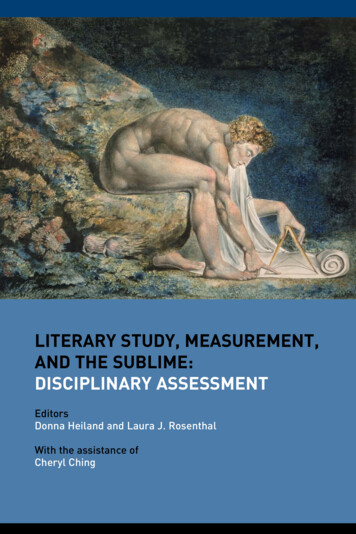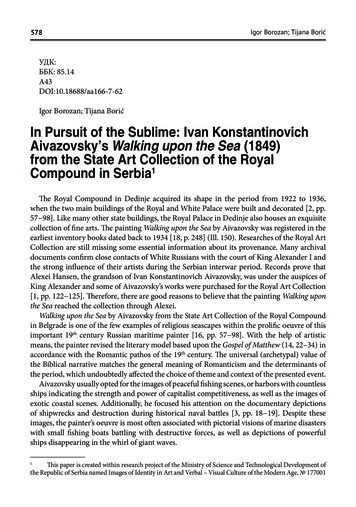
Transcription
578Igor Borozan; Tijana BorićУДК:ББК: 85.14А43DOI:10.18688/aa166-7-62Igor Borozan; Tijana BorićIn Pursuit of the Sublime: Ivan KonstantinovichAivazovsky’s Walking upon the Sea (1849)from the State Art Collection of the RoyalCompound in Serbia1The Royal Compound in Dedinje acquired its shape in the period from 1922 to 1936,when the two main buildings of the Royal and White Palace were built and decorated [2, pp.57 98]. Like many other state buildings, the Royal Palace in Dedinje also houses an exquisitecollection of fine arts. The painting Walking upon the Sea by Aivazovsky was registered in theearliest inventory books dated back to 1934 [18, p. 248] (Ill. 150). Researches of the Royal ArtCollection are still missing some essential information about its provenance. Many archivaldocuments confirm close contacts of White Russians with the court of King Alexander I andthe strong influence of their artists during the Serbian interwar period. Records prove thatAlexei Hansen, the grandson of Ivan Konstantinovich Aivazovsky, was under the auspices ofKing Alexander and some of Aivazovsky’s works were purchased for the Royal Art Collection[1, pp. 122 125]. Therefore, there are good reasons to believe that the painting Walking uponthe Sea reached the collection through Alexei.Walking upon the Sea by Aivazovsky from the State Art Collection of the Royal Compoundin Belgrade is one of the few examples of religious seascapes within the prolific oeuvre of thisimportant 19th century Russian maritime painter [16, pp. 57 98]. With the help of artisticmeans, the painter revised the literary model based upon the Gospel of Matthew (14, 22–34) inaccordance with the Romantic pathos of the 19th century. The universal (archetypal) value ofthe Biblical narrative matches the general meaning of Romanticism and the determinants ofthe period, which undoubtedly affected the choice of theme and context of the presented event.Aivazovsky usually opted for the images of peaceful fishing scenes, or harbors with countlessships indicating the strength and power of capitalist competitiveness, as well as the images ofexotic coastal scenes. Additionally, he focused his attention on the documentary depictionsof shipwrecks and destruction during historical naval battles [3, pp. 18 19]. Despite theseimages, the painter’s oeuvre is most often associated with pictorial visions of marine disasterswith small fishing boats battling with destructive forces, as well as depictions of powerfulships disappearing in the whirl of giant waves.1This paper is created within research project of the Ministry of Science and Technological Development ofthe Republic of Serbia named Images of Identity in Art and Verbal – Visual Culture of the Modern Age, 177001
Русское искусство XVIII–XIX веков579The general theme of marine disasters became a paradigm of Aivazovsky’s works [22,pp. 182 187]. The common theme of his monumental seascapes implied a powerful contrastbetween a human being and elements of nature [12, p. 128]. Helpless shipwrecked figuresset in a vastness of the sea suggested how powerless a human being is, comparing to thecapricious forces of nature. Left without faith and hope, a miniature individual disappears intothe cosmologically determined Universe, thus becoming a mere statist in a tragic staging ofthe destructive power of sublime nature.The term sublime was introduced into aesthetic categorical dictionary in the middle ofthe 18th century [15, pp. 4 10]. The sublime is essentially defined as human fascination withterrifying images and angry scenes. Dynamic and vibrant experience of the sublime transcendsany material sense becoming a paradigm of discovering unconscious aspects of a humanpsyche. Therefore, the image of a storm becomes one of the key toponyms of the feeling of thesublime. Fear of destructive forces provokes the sense of the aesthetics of the sublime, thusconfirming the concept of enjoying the terrible scenes and destructive forces of natural order.Edmund Burke’s treatise A Philosophical Enquiry into the Origin of our Ideas of the Sublime(1757) codified this discomfort in front of the artistic scenes [15, pp. 48 71]. He defined anumber of elements that later became program idioms of Dark Romanticism. Fear, uncertainty,obscurity, horror create feelings of despair, pain, and loneliness which are jointly manifestedin front of horrifying images.This painting from the State Art Collection corresponds to some extent to the establishedtypical scenes of marine disasters, somewhat modified due to the particular time and historicalcircumstances.As a student of the Imperial Academy in St. Petersburg, Aivazovsky visited Italy to finishhis education [14, p. 58]. During his trip to Italy (the Grand Tour) the painter visited Naples[4, pp. 203–230], an unavoidable topos of all pilgrimages to southern Italy [6, pp. 135–155].The city of the sublime pathos was largely defined by the mythical projection of catastrophiceruption of Vesuvius in 79 B. C. [4, pp. 236–257]. During his travels across Italy, Aivazovskymust have witnessed the outstanding fame of the notable painting The Last Days of Pompeiiby Karl Pavlovich Bryullov [22, p. 184]. The Romantic sublime pathos in visual and verbalculture of the epoch coincided with the natural circumstances of the Vesuvius eruption in1834, which undoubtedly fostered the pathos of horror during the 1830s and 1840s.The overall feeling of Dark Romanticism rested largely on human subconsciousness [12].Instability of ideas and oddity of forms had their roots in the unconscious and untested depthsof human psyche. In his canonic book The Romantic Agony Mario Praz defined the scopeof Romantic dark mood [22, p. 184]. Literary sources, largely based on response to Gothicnovels, produced a reaction in visual arts. Fear, discomfort and irrationality were visualizedby ghostlike images, grotesque phenomena and imaginary creatures corresponding to artisticimagination and creative freedom of Romantics, confirming the eruption of the repressedworld of dreams. Nocturnal images united these typical figures in a unique pictorial world ofDark Romanticism testifying to the unique feeling of uneasiness within academic and nonacademic art [12, pp. 14–28].Walking upon the Sea embodies the above structural phenomena in media system of DarkRomanticism. At the same time, formal and conceptual framework of this presentation of water
580Igor Borozan; Tijana Borićleads us to the key segments of the rhetoric of political semantics [21, pp. 89–126]. From theperspective of political iconography, the storm undoubtedly reveals the relationship betweenthe main structures of the painting [7, pp. 409 415]. As a focal and symbolic center of thecomposition, Christ is categorically defined in regards to the storm calmed by his presence. Inthe emblematic political vocabulary, the storm indicates social and political instability, whichis usually calmed by a decisive figure of a leader (monarch). The one who restrains the stormbrings stability to the community and state, becoming a guarantor of the upcoming period ofpeace and abundance. Schiller defined a Romantic concept of distinguishing causal, moodyand capricious nature, and a human as a moral being with freedom of choice. In his painting,Aivazovsky presents Christ as a paragon of morality, who chooses his fate by calming theunstable world of devastating, immoral nature and setting a human in a free relationship withforces that are seemingly beyond his control. Like a chosen and predestined Romantic genius,Christ enters the whirl of the elemental forces, subordinating them in the name of humanity.By his presence, he sets the apostles free from fear, turning their skepticism and infidelityinto hope and faith. Aivazovsky uses the image of Christ and turbulent nature to visualizethe essence of Romanticism, sublimed in the paradox of duality. The duality of Romanticismis based on the dichotomy and collision of opposing forces. In this case, the transcendentalfigure (vision) of Christ and and vibrant material nature are the expression of the dialectics ofopposites, peace and turbulence. The collision of the opposing energies is resolved, and it isthrough Christ that Romantic instability is balanced.Scholars have highlighted a strong correlation of natural disasters and actual politicalcircumstances in Aivazovsky’s oeuvre. From this perspective, the seemingly destructivenatural forces in the Ninth Wave, dated 1850, reveal active political influences pointing to thefailure of the Polish Revolution of 1831 [22, pp. 182, 186]. In the eyes of the contemporariesthis seascape was transformed into a visual political pamphlet. The prerevolutionary yearsin European countries must have left a deep trace in the artist’s soul. Turbulent politicalatmosphere in Italy, Germany, Austria and France was undoubtedly to affect the artist whopainted Walking upon the Sea in the year of the revolution. They coincide with the religiousspirit of Millennialism and the faith in the imminent end of the world after a thousand yearslong Christ’s kingdom on Earth [11, pp. 138 139]. Frightening images of wild nature andreligious apocalyptic mood are also featured in the artworks of John Martin [11, pp. 125 146].Through the language of symbols, a message is sent to Russian and European public. Stabilityand order preserved in Russia, untouched by the revolutionary earthquake became a model ofa good government and religious authorities. Christ is interpreted as a religious comforter ofthe Russian congregation frightened by the revolution. He enters people’s hearts offering themreligious appeasement at the time of considerable religious upheavals. Thoughts about theend of the world, which were undoubtedly fostered by social and political turmoil throughoutEurope, threatened to destabilize Russian society. In Aivazovsky’s vision, Christ’s constancyis turned into a political apologia for the Russian constitutional concept of religiosity and theimperial autocracy [23]. Christ becomes a metaphor for an earthly king who offers a shelterto the people. The small boat with fishermen (apostles) becomes an emblematic metaphor forthe state and the Church boat that still floats on rough seas. Stormy sky, gloomy sea and rockycoastline are restrained by the appearance of Christ. It seems that Aivazovsky intentionally
Русское искусство XVIII–XIX веков581chose the scene where Christ appears a front of the Apostles as a ghost: ghostlike imageswere popular in the culture of Romanticism. However, Christ quickly calms the apostles withwords “Fear not, for I am with you; do not be dismayed”. He sets their doubts, the existentialparadigm of Romantic skepticism, into the framework of acceptable mystery of walking uponthe sea. Christ is seen as a kind of a wizard who acts between the fine line of the acceptableinstitutionalized Christian faith and mysterious character of the Romantic religiosity. Facialexpressions and corporal rhetoric of the presented apostles reveal a state of shock caused by theappearance of a mysterious stranger who walks ghostlike thus confirming the somnambulatorycharacter of the imagination that turns Christian mystery into the Romantic effectiveness.The nearly phantasmagoric image of Christ is not only the emblematic pictogram, butrather an independent entity, which creates the formal vision of this piece. The image of theSavior acts as a light factor (reflector) that in Aivazovsky’s works was often associated withthe image of the Moon. Its luminous aura further emphasizes the academic mastership of theartist. This aura is evident in the depiction of waves and stormy sea. In such masterly partsand precisely executed details, the craftsmanship based on Dutch marine painting reachedits climax [14, p. 64]. In foamy waves and shades of dark blue sea, we recognize the accuracyand skillfulness of workmanship, which paradoxically complete the somnambulistic figure ofChrist. Christ’s image becomes almost an autonomous art form announcing the impressionistcolor and light in the artist’s later works.Aivazovsky used Christ’s figure as a core element in presentation of the apostles in theboat. The bodies of apostles have academic features. The fishermen actively participate in thiscosmic landscape image. The painting differs in this respect from the common practice ofrepresenting miniature human figures in gigantic scenes of shipwrecks. The presence of theproperly set human figures confirms constancy of the academic painting and the presumedcredibility of the image. The presentation of the coastline can be interpreted either as a fictionor as drawn from nature. It helps us to decode this complex composition. In the given context,we can observe the presentation of the coastline in the upper right corner. The nuancedrocky coastline, which is shrugging from the dominant section of the sky, could be the realrepresentation of one of the many seas (lakes) that the artist visited during his artistic andscientific trips. The artist’s topographic accuracy, verified by his education and his experienceas the official painter of the Russian Naval Ministry, tamed the unrestrained Romanticapproach. At the same time, the collapsing coast might be conceived as a fiction, a paraphraseof the Sea of Galilee, where the famous event of Walking upon the Sea took place. During hislifetime, Aivazovsky visited all the major European sea lines [3, p. 17], expending his existingempirical knowledge of water surfaces, which he acquired on the shores of his native city onthe Black Sea coast. The craggy landscape is certainly a reminiscence of the event that tookplace immediately before the meeting of Christ and the apostles on the lake. It symbolicallyrecreates the rocky ground where (after the miracle of multiplication of bread and wine)Christ secluded himself in a prayer. Obviously, Aivazovsky creates a symbolic narrative, andso he creates simultaneous action flow that culminates in the presentation of the sea. Abovethe rocky coast, a ray of light emerges. It penetrates the prevailing darkness of the left part ofthe image, thus pointing to the fruitful effects of Christ’s prayer, represented by symbolicallight on this mainly dark representation.
582Igor Borozan; Tijana BorićThe virtuoso treatment of the composition Walking Upon the Sea fits into the general readingsof Ivan Aivazovsky’s oeuvre as the artist sets this image in between mythical, Christian andsymbolic (emblematic) interpretation. The documentary character of this image is transformedinto presentation of deep feelings and universal values, which makes a historical event processedinto the fiction synchronized with intellectual and artistic frames of time. The moral-didacticmessage did not allow the painter to leave the basic academic postulates (drawing, humanfigure.), and the picture remains a pictorial example of variations on the theme of the antitheticalparadox of Romanticism (classical in artistic form and Romantic in emotional response).Walking upon the Sea can be understood as part of an imaginary triptych that IvanAivazovsky created half a decade later. In 1888, the artist painted the image of the same name.In this version, he chose a moment when Peter was drowning for his skepticism and doubts.The following year, Aivazovsky again made the image, in which he represented the culminationof this Biblical story. It is the moment when Christ saves apostle Peter from the rippling water.If the original version of the composition Walking upon the Sea was of didactic tone aimed atthe transformation of potential addressees, then the two latter eponymous images seemed likethe existential visual pamphlet of the elderly artist. The universality of the message and politicalsemantics of the initial painting were abandoned. These images now become representations ofa personal relationship between Christ and Peter indicating indirectly to an internal religiosityof the author. The artist’s soul turns to the scene of an internal spiritual struggle, which revealsa romantic individual in his perpetual psychological struggle.However, the author chose to follow the Biblical story bringing the trilogy into a singlestructural chronotope. Created in a large time span, those three works are connected viaformal logic embodied by the use of optical phenomena and appropriate symbolic allusions.Nocturnal pathos of the three compositions confirms the long duration of late Romanticism.It verifies the structural coherence of this art movement based upon conceptual, formal andthematic similarities (meanings), and, primarily, on common feelings.All the three seascapes are composed with a background constituted of real and fictionalelements. The initial episode of the trilogy, the focus of our research, affirms paradigmatic unitybetween the painter’s imagination and the real nature presentation. Fantasying as a processof imagination requires the absence from the direct observation of nature. The process ofimagination enlarged the distance between the observer and nature, turning it into a topos ofthe otherness. From a safe distance, the observer imagines (creates) the landscape that he oncesaw and then converts it into his own mental image. Undoubtedly, such an action determinedthe artistic way of thinking for Ivan Aivazovsky as illustrated by the piece Walking upon theSea, dated 1849. The seascape developed into the object of his intellectual and creative fantasy.The concept of imaginary landscape [20, pp. 174–182] is based upon visionary processingof detailed memories of nature, and Walking upon the Sea is a fine example of such a process.According to testimony of Ilya Ostroukhov, landscapes are created on excerpts of memorybased on previous exact studies of nature [14, pp. 63–64]. As a result, the painter’s impressionsof nature combine with his personal feelings and imagination [14, p. 64].This is the approach that Aivazovsky used in creating his seascape Walking upon the Sea.Beyond the limits of nature, but still a part of it, the painter presented the biblical themeappropriate to the visionary spirit of the time. Shaped as artificial and aestheticized space, the
Русское искусство XVIII–XIX веков583seascape became a field of the artist’s anthropomorphic projections. The Romantic sublimityand sensitivity of the artist interlaced with cultural and ideological frameworks of the period.His reflections of the political and social events were transformed into the timeless story withbiblical roots. This story expresses the universality of the message of suffering and salvation.Therefore, the seascape became a projection of a contemporary man, his complex attitudestowards religion and nature, his place in the mysterious Universe [10, pp. 1–18]. Finally, thepainting Walking upon the Sea from the State Art Collection in Belgrade demonstrates theartist’s virtuoso technique and his craftsmanship perfection. It confirms the strength of theartwork as a visual stereotype that further testifying social, ideological, cultural and artisticpractices of the mid-nineteenth century Europe and Russia.Title. In Pursuit of the Sublime: Ivan Konstantinovich Aivazovsky’s Walking upon the Sea (1849) from theState Art Collection of the Royal Compound in SerbiaAuthors: Igor Borozan — Ph. D., assistant professor. University of Belgrade, Čika Ljubina 18-20, 11000Belgrade, Serbia. borozan.igor73@gmail.comTijana Borić — Ph. D., assistant professor. University of Niš, Kneginje Ljubice, 10. 18000 Niš, Serbia.tijanaboric@hotmail.comAbstract. The indescribable idea of the sublime fascinated and challenged the famous nineteenth centuryartist Ivan Konstantinovich Aivazovsky, whose dwelling upon this concept gave rise to countless visualresponses. In this paper, we examine the earliest known version of his piece known as Walking upon theSea, dated 1849, from the State Art Collection of the Royal Compound in Serbia. This particular image isa peculiar combination of the stormy sea at night and religious theme that embodies the artist’s inner selfobservations, thoughts, worldview, and the perceptive power of the years to come. Aivazovsky was a man ofRomanticism and a visionary genius as well. He was occupied with the ideas of infinity, great drama and ofthe divine that challenges viewers’ senses of space and time. Walking upon the Sea,, the art piece of its time,is a manifest reflection of skepticism of the era, groundbreaking experiments, innovations, and discoveries.Keywords: Aivazovsky; Romanticism; sublime; skepticism; emotional tuning; deification of nature.Название статьи. В поисках возвышенного: «Хождение по водам» И. К. Айвазовского (1849) изГосударственного художественного собрания Королевского дворца в Сербии.Сведения об авторах. Борозан Игорь — Ph. D., ассистент. Белградский университет, Чика Любина, 18‒20, 11000, Белград, Сербия. iborozan@f.bg.ac.rsБорич Тияна — Ph. D., ассистент. Нишский университет, Кнегиние Любиче, 10, Ниш, Сербия,18000. tijanaboric@hotmail.comАннотация. Не поддающаяся словесному выражению романтическая категория «возвышенного»увлекала и искушала знаменитого художника XIX столетия Ивана Константиновича Айвазовского.Свои размышления о нем он воплотил в многочисленных визуальных образах. Статья посвящена самому раннему известному варианту его картины «Хождение по водам» (1849), которая недавно былавновь открыта и представлена после реставрации и консервации в Государственном художественномсобрании (Королевский дворец, Белград). Предложена попытка анализа этой своеобразной работы,в которой ночной пейзаж штормящего моря неожиданно стал выражением религиозной темы, поданной сквозь призму внутреннего мира художника, его мыслей, мировоззрения и провидения огрядущих годах. Айвазовский был человеком эпохи романтизма и гением-визионером. Его думы волновали понятия «бесконечного», «божественного», «великой драмы», которые ломали традиционноевосприятие пространства и времени в изобразительном искусстве. «Хождение по водам» — произведение своей эпохи, отчетливо отразившее скептицизм эры революционных научных открытий иэкспериментов. Большое внимание в статье уделено особенностям картины, свидетельствующим остремлении художника настроить эмоции зрителя, и художественным приемам, с помощью которых он достигает нового драматического эффекта. Кроме того, предпринята попытка объяснить выбор религиозной темы, очевидно несовместимой с романтическим мировоззрением, и выявить, какона соотносится с категорией «возвышенного». Впоследствии Айвазовский вернется к этой теме поменьшей мере дважды. В заключение приведен анализ символического языка художника и средств,
584Igor Borozan; Tijana Borićкоторые он использовал, чтобы настроить свой внутренний взор для претворения реальности в художественные образы своих произведений.Ключевые слова: И. К. Айвазовский; человек эпохи романтизма; категория «возвышенного»;скептицизм; эмоциональное содержание; обожествление природы.References1.Acović D. etc. Slika ruske duhovnosti u Kraljevskom dvoru (The Image of the Russian Spirituality in theRoyal Palace). Beograd, Kraljevski dvor Publ., 2013. 32 p. (in Serbian).2. Babac D. etc. Dvorski kompleks na Dedinju (The Royal Compound in Dedinje). Beograd, Zavod zaudžbenike i nastavna sredstva Publ., 2012. 285 p. (in Serbian).3. Böhme H. Traditionen unf Formen der aquatischen Ästhetik in der Kunst Iwan Aiwasowskis.Aiwasowski. Maler des Meeres. Ostfildern, Hatje Caentz Verlag Publ., 2011, pp. 15 35 (in German).4. Brajović S. Njegoševo veliko putovanje. Meditacije o vizuelnoj kulturi Italije (Njegoš’s Great Journey.Meditations on Visual Culture in Italy.). Podgorica, Institute for Language and Literature “Petar PetrovićNjegoš” Publ., 2015. 316 p. (in Serbian).5. Brugger I.; Kreil L. (ed.) Aiwasowski. Maler des Meeres. Ostfildern, Hatje Caentz Verlag Publ., 2011.168 p. (in German).6. Cardinal R. Romantic Travel. Rewriting the Self. Histories from the Renaissance to the Present. London —New York, Routlegde Publ., 1997, pp. 135 155.7.Donandt R. Sturm. Handbuch der poltischen Ikonographie, Bd. II: Imperator bis Zwerg. Munich, VerlagC. H. Beck Publ., 2011, pp. 409 415 (in German).8. Gardner Coates V.; Lapatin K., Seydl J. L. (eds.) The Last Days of Pompeii: Decadence, Apocalypse,Resurrection. Los Angeles, J. Paul Getty Museum Publ., 2012. 256 p.9.Holms R. Doba čuda: kako je pokolenje romantičara otkrilo lepotu i užas nauke. Beograd, Dosije StudioPubl., 2011. 572 p. (in Serbian).10. Kohle H. Arnold Böcklins Halluzionationen Malerei im Zeitalter der Psychologie. Kunstgeschichte. OpenPeer Reviewed Journal, 2009. Available at: http://www.kunstgeschichte-ejournal.net/98/ (accessed on 23March 2016) (in German).11. Kohle H. Katastrophe als Strategie und Wunsh. Englische und deutsche Landshaftsmalerei des 19. undfrühnen 20. Jahrhunderts. AngstBilderShauLust. Katastrophenerfahrungen in Kunst, Musik, und Thetaer.Berlin, Henschel Publ., 2007, pp. 125 146 (in German).12. Krämer F. (ed.) Dark Romanticism. From Goya to Max Ernst. Ostfildern, Hatje Cantz Verlag Publ., 2009.304 p.13. Prac M. Agonija romantizma. Beograd, Nolit Publ., 1974. 459 p. (in Serbian).14. Samarine I. Die Welt im Licht einer Laterna magica des Ostens. Iwan Aiwasowskis Stellung in derrussischen und europäischen Kunst. Aiwasowski. Maler des Meeres. Ostfildern, Hatje Caentz VerlagPubl., 2011, pp. 51–66 (in German).15. Shaw P. The Sublime, the New Critical Idiom. London — New York, Routledge Publ., 2006. 168 p.16. Shumova M. N. (ed.) Russkaia zhivopisэ pervoi poloviny XIX veka (Russian Painting of the First Half ofthe 19th Century). Moscow, Iskusstvo Publ., 1978. 168 p. (in Russian).17. Tarasov O. Icon and Devotion. Sacred Spaces in Imperial Russia. London, Reaktion Books Publ., 2002.448 p.18. Todorović J. Katalog državne umetničke kolekcije Dvorskog kompleksa u Beogradu I. Evropska umetnost(Catalogue of the State Art Collection in the Royal Compund in Belgrade I. European Art). Novi Sad,Platoneum Publ., 2014. 307 p. (in Serbian).19. Vasić R. Konzervatorsko-restauratorski radovi na slici Hrist hoda po vodi ruskog slikara IvanaKonstantinoviča Ajvazovskog. Available at: og saizlozbe dani ruskih duhovnih slikara.pdf (accesed on 27 January 2016).20. Vaughan W. Romanticism and Art. London, Thames and Hudson Publ., 1978.21. Warnke M. Political Landscape. The Art History of Nature. London, Reaktion Books Publ., 1994. 168 p.22. Wessolowski T, Naturkatastrophe. Handbuch der poltischen Ikonographie, Bd. II: Imperator bis Zwerg.Munich, Verlag C. H. Beck Publ., 2011, pp. 182 187 (in German).23. Wortman S. R. Scenarios of Power. Myth and Ceremony in Russian Monarchy. From Alexander II to theAbdication of Nicholas. Princeton — New Jersey, Princeton University Press Publ., 2000. 512 p.
Иллюстрации901Илл. 148. Ян ван Хухтенбург.Батальная сцена.Нач. XVIII в. й музейизобразительных искусствИлл. 149. Ян ван Хухтенбург.Битва при Рамильи междуфранцузами и союзниками23 мая 1706 года. 1706–1710.Рейксмузеум, АмстердамIll. 150. I. K. Aivazovsky.Walking upon the Sea. 1849.The State Art Collection ofthe Royal Compound inDedinje, Belgrade, Serbia
The sublime is essentially defined as human fascination with terrifying images and angry scenes. Dynamic and vibrant experience of the sublime transcends any material sense becoming a paradigm of discovering unconscious aspects of a human psyche. Therefore, the image of a storm becomes one of the key


